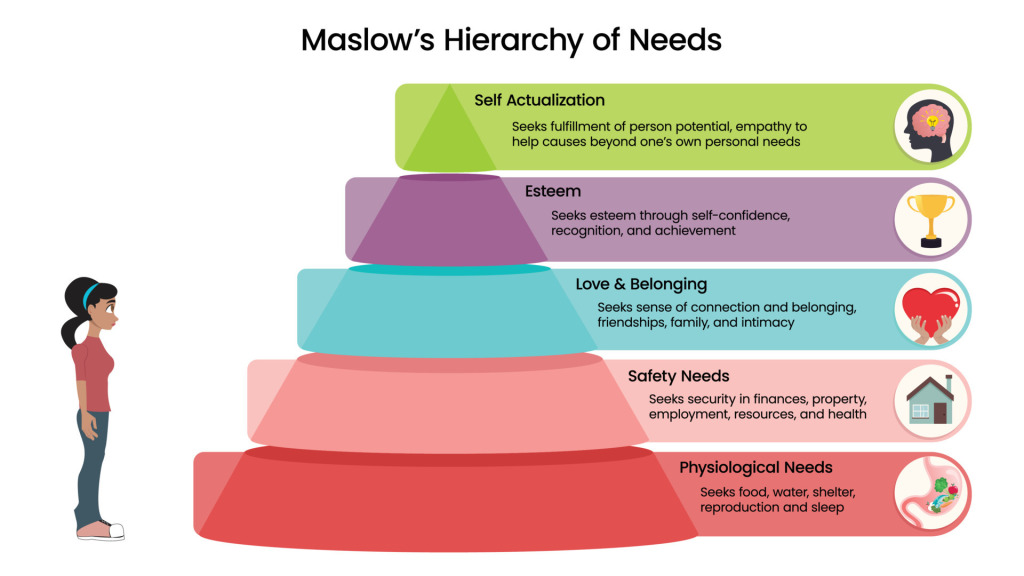Non-nursing theory in healthcare
Maslow’s Hierarchy of Needs is a well-known psychological theory that describes the different levels of human needs and the motivation behind human behavior. This theory has been extensively applied in various fields, such as education, management, and social work. However, its application in healthcare, specifically in a non-nursing context, is still relatively unexplored. In this paper, we will discuss the potential applications of Maslow’s Hierarchy of Needs in healthcare, focusing on its relevance and effectiveness in addressing the diverse needs of patients.
Maslow’s Hierarchy of Needs is based on the premise that humans have a set of basic needs that must be met before they can achieve higher levels of satisfaction and motivation. These needs are arranged in a hierarchical structure, with the most basic needs at the bottom and the highest needs at the top. The five levels of needs in Maslow’s Hierarchy are physiological, safety, love and belongingness, esteem, and self-actualization.
At the base of the hierarchy are the physiological needs, which include the need for food, water, and shelter. In the context of healthcare, these needs are often addressed by providing patients with nourishment, medications, and a comfortable environment. However, in non-nursing roles, healthcare professionals may not have the direct responsibility of fulfilling these basic needs. Still, understanding their importance and ensuring that they are met for patients can positively impact their overall well-being and recovery.
The next level is safety needs, which include physical and emotional security. In healthcare, this can refer to providing a safe and clean environment for patients, as well as ensuring their emotional safety by addressing their fears and concerns. For non-nursing professionals in healthcare, this can involve working with the nursing team to maintain a safe environment and being aware of potential hazards that may affect patients’ safety.
The third level is love and belongingness needs, which refer to the need for social relationships and a sense of belonging. Patients in healthcare settings often experience a sense of isolation and loneliness, which can negatively impact their recovery. Non-nursing professionals can play a crucial role in addressing these needs by providing emotional support, engaging patients in activities, and facilitating social interactions.
The fourth level is esteem needs, which include the need for self-respect and the respect of others. In a healthcare setting, it is important to recognize and acknowledge patients’ accomplishments and strengths, as well as treating them with respect and dignity. Non-nursing professionals can contribute to fulfilling these needs by empowering patients and involving them in decision-making processes regarding their care.
The final level is self-actualization needs, which refer to the fulfilment of one’s full potential and personal growth. While this level may not seem applicable in a healthcare setting, promoting self-care and encouraging patients to take an active role in their recovery can contribute to their self-actualization. Non-nursing professionals can provide education and resources to patients to support their self-care practices and help them achieve their full potential.
Benefit of applying Maslow’s Hierarchy of Needs in healthcare
One of the key benefits of applying Maslow’s Hierarchy of Needs in healthcare is its holistic approach to addressing patients’ needs. This theory acknowledges that individuals have diverse needs that must be met, and neglecting one need can hinder their overall well-being and recovery. By viewing patients through the lens of the hierarchy, healthcare professionals can better understand and address their needs, leading to improved patient outcomes.
Moreover, Maslow’s Hierarchy of Needs allows for individualized care, as each patient’s needs and motivations may differ. This is particularly important in non-nursing roles, where healthcare professionals may have limited direct contact with patients but can still contribute to their well-being through understanding their unique needs.
Limitation to the application of Maslow’s Hierarchy of Needs in healthcare
Despite its potential benefits, there are some limitations to the application of Maslow’s Hierarchy of Needs in healthcare. One criticism is that the hierarchy is not a fixed structure and that individuals may not progress through the levels in a linear manner. Additionally, the theory does not account for external factors that may affect an individual’s needs, such as cultural and environmental influences.
Conclusion
In conclusion, Maslow’s Hierarchy of Needs has the potential to be a valuable tool in the non-nursing context of healthcare. By understanding and addressing patients’ diverse needs, healthcare professionals can contribute to their overall well-being and recovery. However, it is important to acknowledge the limitations and potential criticisms of the theory and use it in conjunction with other approaches to provide comprehensive care for patients. As healthcare continues to evolve, the application of Maslow’s Hierarchy of Needs can further be explored and refined to better support patients’ needs and improve healthcare outcomes.









